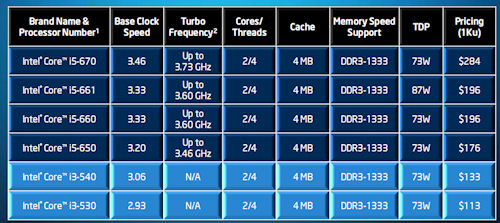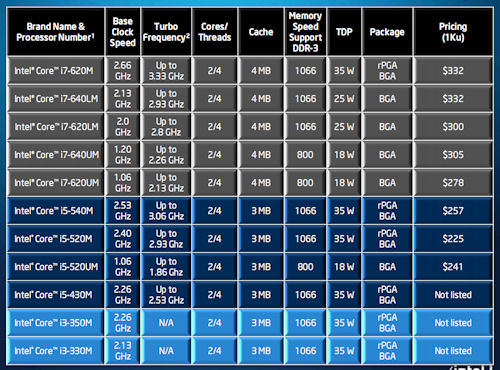Clarkdale, Arrandale, Core i3. Core i5, Core i7 - help
We've disseminated what Westmere is and how it works, together with the mojo that is package-integrated graphics...but architecture is nothing without product.As mentioned earlier, Intel is rolling out six desktop and 11 mobile Westmere chips. Lest we forget, desktop models are codenamed Clarkdale and mobile versions are Arrandale.
Core i3 and Core i5
Here are the six desktop models that feature the Westmere underpinnings. All chips contain two processing cores and a further two virtual cores by way of hyper-threading. If you've kept up with the explanations thus far, they all carry integrated graphics on the same package, too.
By way of architecture, all are equipped with 32KB of L1 cache, 256KB of L2 cache and a shared 4MB of L3 - making them 'half' of a Lynnfield CPU. Further, each chip interfaces with a dual-channel memory-controller that has official support for DDR3-1,333 memory, but will, most likely, run much higher on enthusiast-class motherboards.
Intel splits Clarkdale into Core i3- and Core i5-branded chips. Core i3 models are (deliberately) bereft of the Turbo Boost feature that increases core speed on a load-balanced basis. Priced in units of 1,000, Core i3s are significantly cheaper than Core i5s, starting at £113 (£80) and targeted towards low-end Core 2 and a plethora of AMD chips.
Core i5 models are imbued with a 'two-click' Turbo Boost feature, meaning that single-core speeds can increase by up to 266MHz. Intel isn't providing as much overclocking headroom as we'd hoped for, and pricing quickly escalates for not a whole heap of gain in base frequency: one will pay a 61 per cent premium for a Core i5 670 that's 8 per cent faster than a Core i5 650.
The only chip to carry a TDP (maximum power-draw) of more than 73W is the Core i5 661. It's different from the rest in a couple of ways. Firstly, its graphics components is clocked in at 900MHz, compared to the 733MHz on all other desktop models - all throttle down to only 500MHz when in 2D. Secondly, it misses out on some of the general features included in the other chips, including vPro Technology, Virtualisation Technology, and Intel Trusted Execution Technology (TXT). In effect, it's aimed at the home user: pure and simple.
Mobile
There are three distinct categories for mobile Westmere chips. Split between Core i3, Core i5, and Core i7, all chips remain dual-core, quad-threaded, replete with integrated graphics. The chips are segregated on the basis of L3 cache, power-draw, memory-controller compatibility, package, and Turbo Boost headroom.
Indeed, it's very difficult to generalise about ranges here, but they all carry integrated graphics clocked in at 733MHz (throttling down to 166MHz in 2D) and the ability to manage overall power-draw such that the Turbo Boost feature can be apportioned to either the CPU or GPU segment (or both) depending upon the workload. It's feasible that the power-control unit will on-the-fly overclock the CPU and GPU when tasked with, say, gaming.
GPU-oriented overclocking is the preserve of the mobile chips, along with switchable graphics, where a discrete card, should it be present, can be turned off in favour of power-saving integrated graphics - and vice-versa. We've touched upon the GPU portion briefly, so let's examine its performance credentials on the following page.











